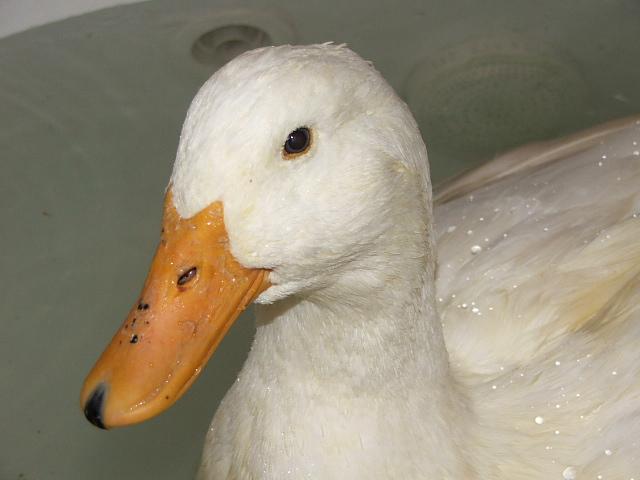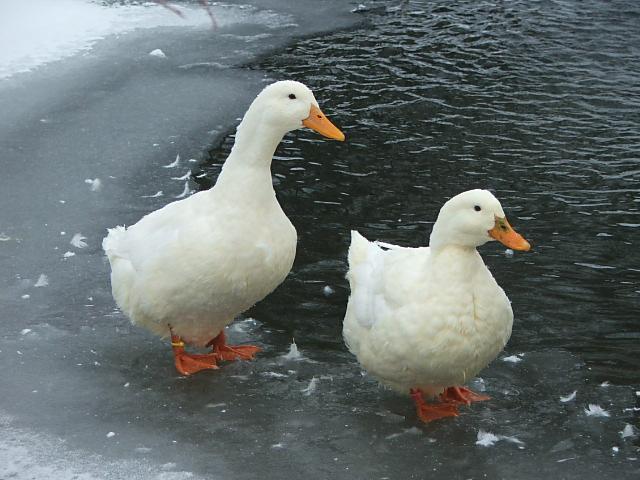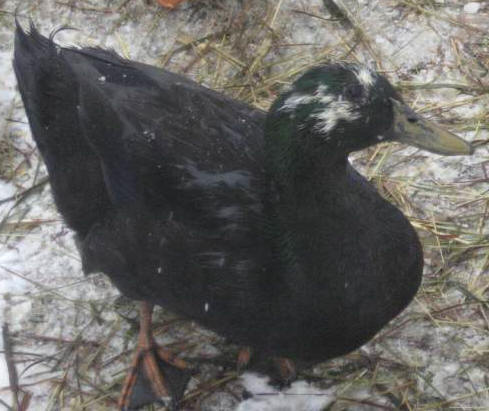"Duck-Duck-Goose"
Blue Ribbon Photo Contest!

Haven't entered our
Blue Ribbon Photo Contest
yet? There's still time!
Each of our two lucky winners will
receive a GORGEOUS metallic blue and silver, 4 tier, rosette
ribbon with three 30 cm long tails and an imprinted silver
"1st" in the center (featured left with Neo).
A personalized Majestic Waterfowl
Sanctuary Winner's Certificate will also accompany each Blue
Ribbon awarded.
Now that is something you and your
feathered friends can proudly display!
There will be two
categories and two First Prizes, one for Most Comical
& one for Most Photogenic. In addition to being
awarded Blue Ribbons and Certificates, winning photos will also be featured
in our April newsletter and on our
Winner's
Circle page.
Rules:
1) Photos
must be of domestic ducks or geese who you have claimed
at least partial responsibility for. This includes
abandoned ducks and geese, still in the wild, as long as
you are helping to care and provide for them on a
regular basis.
2
) Photos
may NOT be digitally modified in any way (except for
cropping, which is allowable).
3 ) You may
include a caption with your photo, but it must be sent
as an attachment, NOT superimposed on the photo itself.
4) Photos
entered must be taken within the last 12 months.
5) Amateur
photos only may be submitted. No
professional or paid photography (unless, of course,
you are a professional photographer).
6) Each
photo entry must be accompanied by a $5.00 entry
donation.
This is a fundraising event, after all!
7) Photos
for this year's competition will be accepted from
January 1, 2009 - March 15, 2009. Both
photographs and full entry donations must be
received by 12:00 pm, midnight on March 15, 2009 in
order to be officially entered. Photos rec'd without
payment will be disqualified. Entry donations are
non-refundable.
8)
Contestants may enter as many photos of their ducks or
geese as they would like
and are encouraged to do so!
Visit our
Blue Ribbon Page for
further information, submission guidelines and to view
photos of our previous winners.
Dig through your favorite photos
or have fun snapping a new one!
Miri Update
We would like to thank
everyone again for your inquiries and well-wishes for our
little Miri-Miri (or Miwi-Miwi as we playfully call her).
She has surprised us all with her strength and love of life
and is hanging in there and doing well.
We will continue to
keep you posted regarding Miri's progress.

Special thanks to
Caroline for donating a heated pet bed to assist in Miri's
care, which she has free access to nest on whenever she
likes.
Thank you also to Beth
for offering to assist with her medical costs and sponsoring Miri.
Ah, Yes...
Spring...
We
have been receiving emails since November regarding lots of
especially feisty ganders and drakes. The many ups and downs
in the temperature seems to have caused some confusion among
the boys in many flocks. Momentary lapses of spring behavior
aside, brace yourselves because the real deal is coming!
As we head into February you can expect
to see a changed attitude among your boys as they begin to
get in gear for spring fever. This is the time of year when
boys often need to be separated from each other. Common
signs of fighting include missing feathers and eye injuries.
Tiny bubbles or foam that forms in or around an eye are a
clear indicator that a duck has been poked in the eye and
this
Eye Trauma
should be taken very seriously. Without intervention
further incidents can lead to blindness of the loss of an
eye.
You also need to pay
special attention to your girls to make sure no single hen
is taking the brunt of your drake's attention. Remember
over-mating of hens can lead to serious reproductive issues.
If your hen is showing signs of stress, as indicated by
feather loss behind her neck and on her back, then you want
to either set up a dividing fence or add more hens to your
flock. Prevention is the best
medicine to avoiding injuries among drakes and hens during
the season of love.

Aladdin
& Jasmine
Valentine's
Day Eggs
This is the
time of year when our geese begin laying eggs. Many of you
out there are waiting to find out if your gander is really a
goose and you may be about to find out. Eggs commonly appear
around February 14th--Valentine's day! So congrats to those
of you who are about to find out that your gorgeous gander
is really a glorious goose and enjoy your omelets!
Dietary
Information for Laying Hens
Mazuri Waterfowl Breeder formula is
the dietary option we have selected for our laying hens and
we have been very pleased with it.
While some laying formulas push
hens to produce a daily egg, taxing their bodies, the Mazuri Breeder
fosters your hens’ needs, supporting them nutritionally throughout
their laying cycles. When not hatching out little ones, we recommend
a ratio of 25% Breeder to 75% Maintenance as long as eggs appear
normal.
If eggs appear rough,
odd shaped or soft, then you want to increase their Breeder
by 25%
each day until you see a positive change in their egg quality. Once
you have stabilized your hen, and eggs look healthy, you want to
slowly work on decreasing her ration of Breeder again. You want to
find that equilibrium—the point where she gets the maximum benefit
from the least amount of Breeder.
It is not uncommon for hens to
require a higher Breeder ratio in the spring and summer—during the
laying season (this can be true even for those hens who lay eggs all
year long). You may have to feed your hens separately, if some of
them have different Breeder ratio requirements. Non-laying hens,
drakes and ganders should not be fed Breeder formula on a regular
basis although it won’t hurt
them if they happen to get into it now and then.
Laying hens should have access to a
calcium source 24/7. You can purchase oyster shells or calcium chips
from your local grain store. This should not be mixed in with their
regular food. Place it in a different feeder. Your hens have the
instincts to know just how much and when to eat this supplement. If
you mix it with their food, you can throw them off.
Outside
Farewells...
 This
is a special message for Judith and her flock in memory of
Timber, a late egg who came to them by chance. He was named
Timber because when he was far too small he would jump into
the sink for a swim.
This
is a special message for Judith and her flock in memory of
Timber, a late egg who came to them by chance. He was named
Timber because when he was far too small he would jump into
the sink for a swim.
He was a handsome
Cayuga drake who died suddenly at age six and his mate
Tumble, a lovely Khaki Campbell lady, misses him every day.
May you fly forever into the sun for you were sincerely
loved...
Big Orange
Big Orange was a ten
and a half year old Buff Orpington hen who was loved dearly
and will be dearly missed. She loved grapes, rice, oats,
duck food and being held. She was the top chicken even in
her old age.
She may not be a duck
or a goose, but we love chickens too and find them truly
wonderful and very loving animals. We know your pain and our
thoughts are with you in your time of loss, Marlys.

